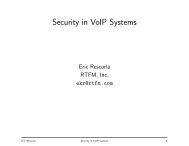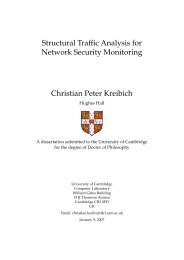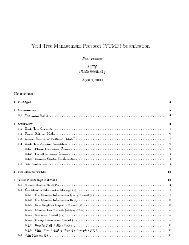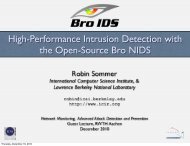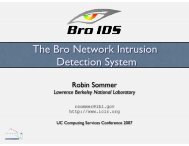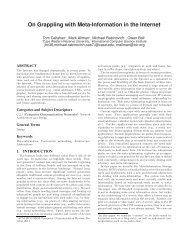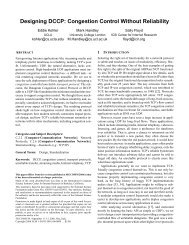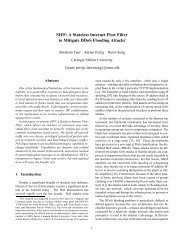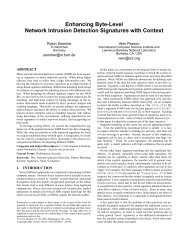Characteristics of Internet Background Radiation - UNC Computer ...
Characteristics of Internet Background Radiation - UNC Computer ...
Characteristics of Internet Background Radiation - UNC Computer ...
You also want an ePaper? Increase the reach of your titles
YUMPU automatically turns print PDFs into web optimized ePapers that Google loves.
GET http://dc.tickerbar.net/tld/pxy.m?nc=262213531 HTTP/1.0<br />
Host: dc.tickerbar.net<br />
Connection: Close<br />
Percentage <strong>of</strong> Source IPs (%)<br />
Figure 8: Typical HTTP request <strong>of</strong> a tickerbar host<br />
100.0<br />
80.0<br />
60.0<br />
40.0<br />
20.0<br />
0.0<br />
LBL UW Class A<br />
(334) (960) (6220)<br />
Data Set(Volume)<br />
Figure 9: Port 135 activities on Mar 29<br />
Other<br />
135/EP24-X2<br />
135/RPC-X1<br />
135/Wel<br />
135/Bla<br />
135/RPC170<br />
135/Bind1<br />
135/empty<br />
TCP Port 135/1025 (DCE/RPC): Port 135 is the Endpoint Mapper<br />
port on Windows systems [10] and one <strong>of</strong> the entry points to exploit<br />
the infamous Micros<strong>of</strong>t Windows DCOM RPC service buffer overrun<br />
vulnerability [37]. This vulnerability is exploited by the Blaster<br />
worm and the Welchia worm among others.<br />
Figure 9 shows the dominant activities on the port. The Blaster<br />
worm was seen on all three networks, but strangely we only saw<br />
the Welchia worm at LBL. There were also a number <strong>of</strong> empty<br />
connections without follow-ups and a few types <strong>of</strong> probes (e.g.,<br />
135/RPC170) we do not understand well. Comparing the activity<br />
distribution across three networks, the difference is striking and unlike<br />
what we see on other ports. This may be due to 1) lack <strong>of</strong> a<br />
single dominant activity and 2) that certain scanning and exploits<br />
might be targeted or localized.<br />
On port 1025, which is open on a normal Windows XP host, we<br />
see a similar set <strong>of</strong> exploits. Further, DCE/RPC exploits are also<br />
seen on SMB name pipes on port 139 and 445. We will present a<br />
closer look <strong>of</strong> RPC exploit in Section 5.2.2.<br />
TCP Port 139/445 (CIFS): Port 139 is the NetBIOS Session Service<br />
port and is usually used on Windows systems for CIFS (Common<br />
<strong>Internet</strong> File System) [7] over NetBIOS. Port 445 is for CIFS<br />
over TCP and is also known as Micros<strong>of</strong>t-DS. When used for CIFS<br />
sessions, the two ports are almost identical except that NetBIOS<br />
requires an extra step <strong>of</strong> session setup. Sources simultaneously<br />
connecting to both ports prefer port 445 and abandon the port 139<br />
connection. Thus we frequently see empty port 139 connections.<br />
As many Windows services run on top <strong>of</strong> CIFS there are a great<br />
variety <strong>of</strong> exploits we see on these two ports. Figure 3 shows a<br />
snapshot <strong>of</strong> exploits we see on port 445 at the Class A network.<br />
There are basically two kinds <strong>of</strong> activities: 1) buffer-overrun RPC<br />
exploits through named pipes, e.g. the Locator pipe [38] or the<br />
Epmapper pipe (connected to the endpoint mapper service); and<br />
2) access control bypassing followed by attempts to upload executable<br />
files to the target host, e.g. as in exploit 445/Samr-exe.<br />
As shown in Table 7, the Locator pipe exploit dominates port<br />
445 activities at all four networks. Besides that, some sources did<br />
not go beyond the session negotiation step — the first step in a<br />
Activity LBL UW Class A<br />
445/empty 2.4% 1.3% 0.9%<br />
445/Nego 3.3% 2.4% 3.7%<br />
445/Locator 72.7% 89.4% 89.3%<br />
445/Samr-exe 11.6% 1.8% 1.1%<br />
445/Samr 2.7% 0.8% 0.6%<br />
445/Srvsvc 1.1% 0.4% 0.8%<br />
445/Epmapper 0.8% 0.3% 0.0%<br />
Other 5.4% 3.7% 3.5%<br />
Table 7: Port 445 activities<br />
CIFS session. We also see exploits that first connect to the SAMR<br />
(Session Account Manager) pipe, then connect to the SRVSVC<br />
pipe and attempt to create an executable file with names such as<br />
msmsgri.exe(W32 Randex.D) [28] and Micros<strong>of</strong>t.exe [1].<br />
Finally, by connecting to the Epmapper pipe the sources are exploiting<br />
the same vulnerability as on port 135/1025 — note that<br />
this activity is not seen at the Class A network.<br />
On port 139, 75% to 89% <strong>of</strong> source hosts either merely initiate<br />
empty connections or do not go beyond the NetBIOS session setup<br />
stage, and then migrate to port 445; The dominant activity that we<br />
accurately identify are attempts to create files on startup folders after<br />
connecting to the SRVSVC pipe Xi.exe(W32-Xibo) [41].Unlike<br />
port 445, we see few hosts attempting to exploit the buffer<br />
overflows on the Locator or Epmapper pipe. We also see Agobot<br />
variants that connect to the SAMR pipe and drop executables.<br />
TCP Port 6129 (Dameware): Port 6129 is listened by Dameware<br />
Remote Control, an administration tool for Windows systems,<br />
which has a buffer overrun vulnerability in its early versions [36].<br />
The Dameware exploits we see are similar to those <strong>of</strong> published exploit<br />
programs but do not have exactly the same payload. To launch<br />
an exploit, the source host will first send a 40 byte message to probe<br />
operating system version and then ship the exploit payload, which<br />
is almost always 5,096 bytes long.<br />
On Mar 29, 2004, 62% <strong>of</strong> the source hosts that connect to port<br />
6129 at LBL 3 close the connections without sending a byte; another<br />
26% abandoned the connections after sending the probe message;<br />
and we see exploit messages from the remaining 12% (the number<br />
is over 30% on Apr 29). It would be reasonable to question if the<br />
large number <strong>of</strong> abandoned connections suggest that the sources<br />
did not like our responders. However, we also find source hosts<br />
that would first connect with an empty connection and later came<br />
back to send an exploit. Port 6129 is associated with the Agobot<br />
that connects a variety <strong>of</strong> ports (see Section 6.1), and possibilities<br />
are that the bots may connect to a number <strong>of</strong> ports simultaneously<br />
and decide to exploit the port that they receive a response from first.<br />
TCP Port 3127/2745/4751 (Virus Backdoors): Port 3127 and<br />
2745/4751 are known to be the backdoor ports <strong>of</strong> the MyDoom<br />
virus and the Beagle viruses, respectively. On most port 3127 connections,<br />
we see a fixed 5-byte header followed by one or more<br />
Windows executable files uploads. The files are marked by "MZ"<br />
as the first two bytes and contain the string "This program<br />
cannot be run in DOS mode" near head <strong>of</strong> the file. Running<br />
several captured executable files in a closed environment reveals<br />
that the programs scan TCP ports 3127, 135, and 445.<br />
On port 2745, the dominant payload we see at LBL and UW is<br />
the following FTP URL, which comes after exchanging <strong>of</strong> one or<br />
Due to an iSink responder problem we do not have data for the UW and<br />
Class A network.




